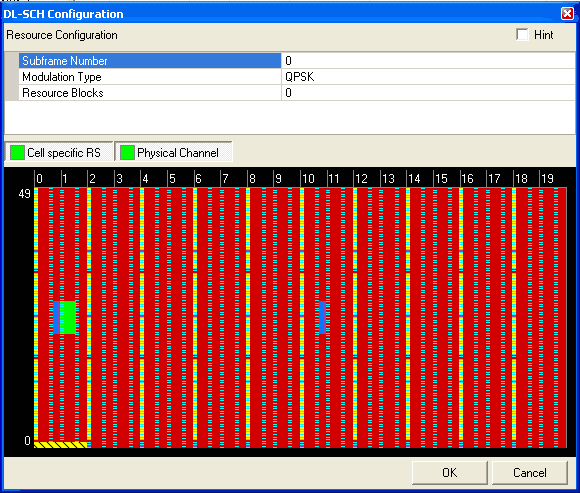 in the Transport
Channel node and select DL-SCH or select an existing DL-SCH channel
in the Transport channel node and click the Edit Channel Configuration
button
in the Transport
Channel node and select DL-SCH or select an existing DL-SCH channel
in the Transport channel node and click the Edit Channel Configuration
button  to open the Configure DL-SCH window.
to open the Configure DL-SCH window. Before adding a DL-SCH channel as described below, delete the default DL-SCH in the Transport Channel node (or any configured DL-SCH that occupies resource blocks that your new DL-SCH will occupy). If you add a new DL-SCH without deleting a conflicting DL-SCH, a "code conflicted" error appears in the Status Bar and the Status Window when you generate the waveform.
Click the Add Channel button
 in the Transport
Channel node and select DL-SCH or select an existing DL-SCH channel
in the Transport channel node and click the Edit Channel Configuration
button
in the Transport
Channel node and select DL-SCH or select an existing DL-SCH channel
in the Transport channel node and click the Edit Channel Configuration
button  to open the Configure DL-SCH window.
to open the Configure DL-SCH window.
The following figure shows the Configure DL-SCH window with the default settings after deleting the existing DL-SCH channel shown in Transport Channel. The currently configured DL-SCH is shown in yellow in the resource mapping graph at the bottom of the window.

Enter the subframe number(s) for the DL-SCH to occupy. You can enter multiple subframes, separated by commas (for example 1,3,5) or a range of subframes (for example 1-5).
Choices: QPSK |16QAM | 64QAM | 256QAM
Default: QPSK
Select the modulation type for the DL-SCH.
256QAM appears in the software's GUI only when Minor Enhancement Update (MEU) Option U03 or greater is valid. Refer to Licenses for more information.
Enter the number(s) of the resource block(s) for the DL-SCH to occupy in both slots of the subframe. You can enter multiple resource blocks, separated by commas (for example 1,3,5) or a range of resource blocks (for example 1-5). Your new configuration is displayed in yellow in the resource mapping graph at the bottom of the window.
Click to create your configured DL-SCH channel. The software automatically creates the appropriate PDSCH channels in the Physical Channel node.